Abstract
We characterized the elastase and antielastase activity of the alveolar fluid of seven patients with the adult respiratory distress syndrome (ARDS) and thirteen normal volunteers. Alpha-1-antitrypsin (A1AT) concentrations were 60-fold higher in ARDS as compared to normal lavage fluid (2,140 +/- 498 nM; 36.1 +/- 4.2 nM, respectively). ARDS fluid antineutrophil elastase activity was also considerably higher than that of normals (979 +/- 204 nM; 31.3 +/- 2.9 nM, respectively). Despite the antineutrophil elastase excess, 5 of 7 ARDS lavage samples contained elastase activity (mean, 6.1 +/- 2.4 pM) as assayed using low-molecular-mass substrate, while only 1 of 13 normal subjects had detectable elastase activity (0.2 pM) (P less than 0.01, compared with ARDS). That this activity was due to alpha-2-macroglobulin (A2MG)-complexed neutrophil elastase was evidenced by (a) the Sephadex G-75 elution profile; (b) the inactivity against insoluble [3H]elastin; (c) the inhibitory profile with phenylmethylsulfonyl fluoride, methoxy-succinyl-alanyl-alanyl-prolyl-valyl-chloromethylketone, ethylene diamine tetraacetic acid, and A1AT; and (d) the immobilization by A2MG antibody bound to polystyrene plates. Furthermore, in agreement with the predicted affinity of A1AT and A2MG for neutrophil elastase, the ratio of A2MG to A1AT in the fluid (0.57%) coincided with the ratio of the A2MG- to A1AT-complexed elastase (0.36%). These findings suggest that the net lung protease-antiprotease balance in ARDS is shifted largely in favor of the antiproteases (chiefly A1AT), and that the antiproteases, A1AT and A2MG, have similar affinities for neutrophil elastase in vivo.
Full text
PDF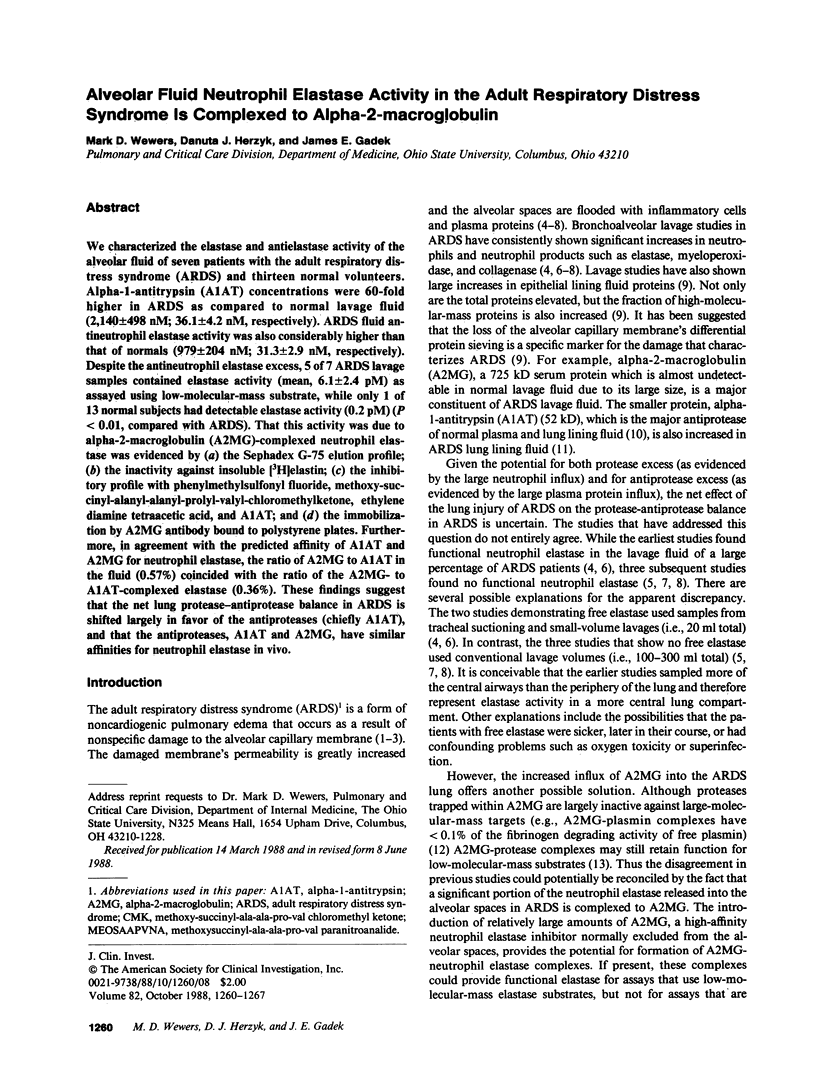

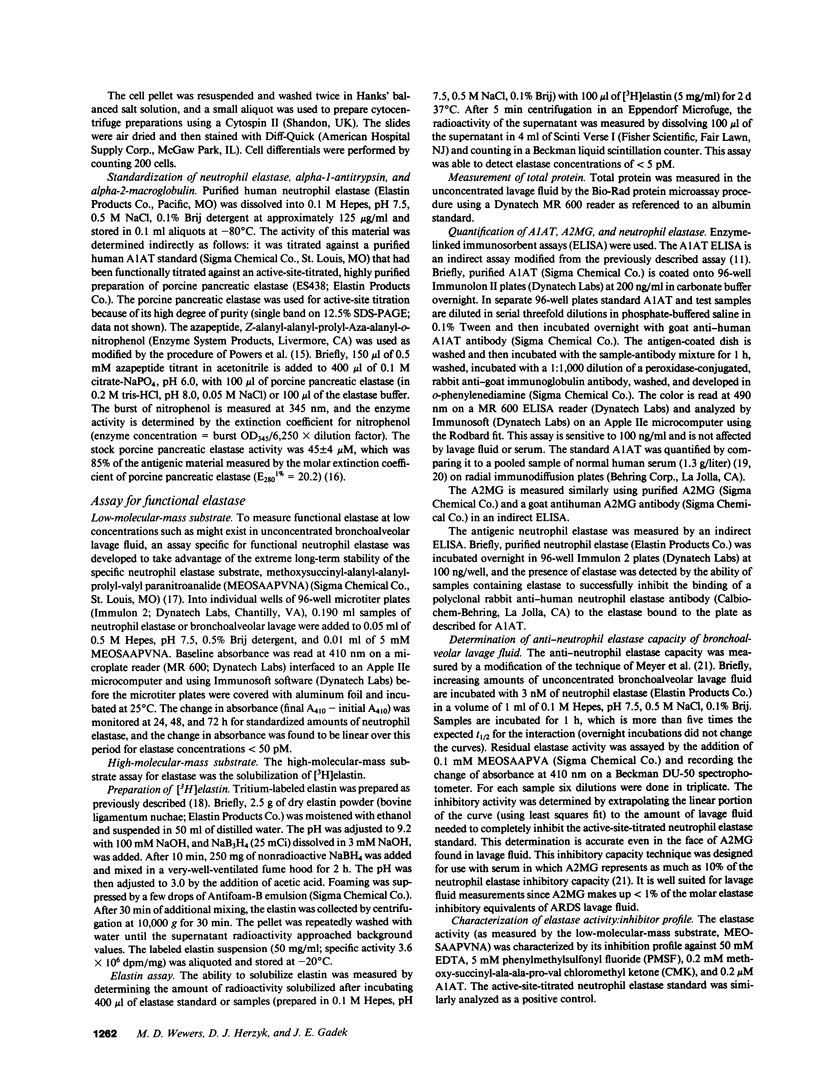
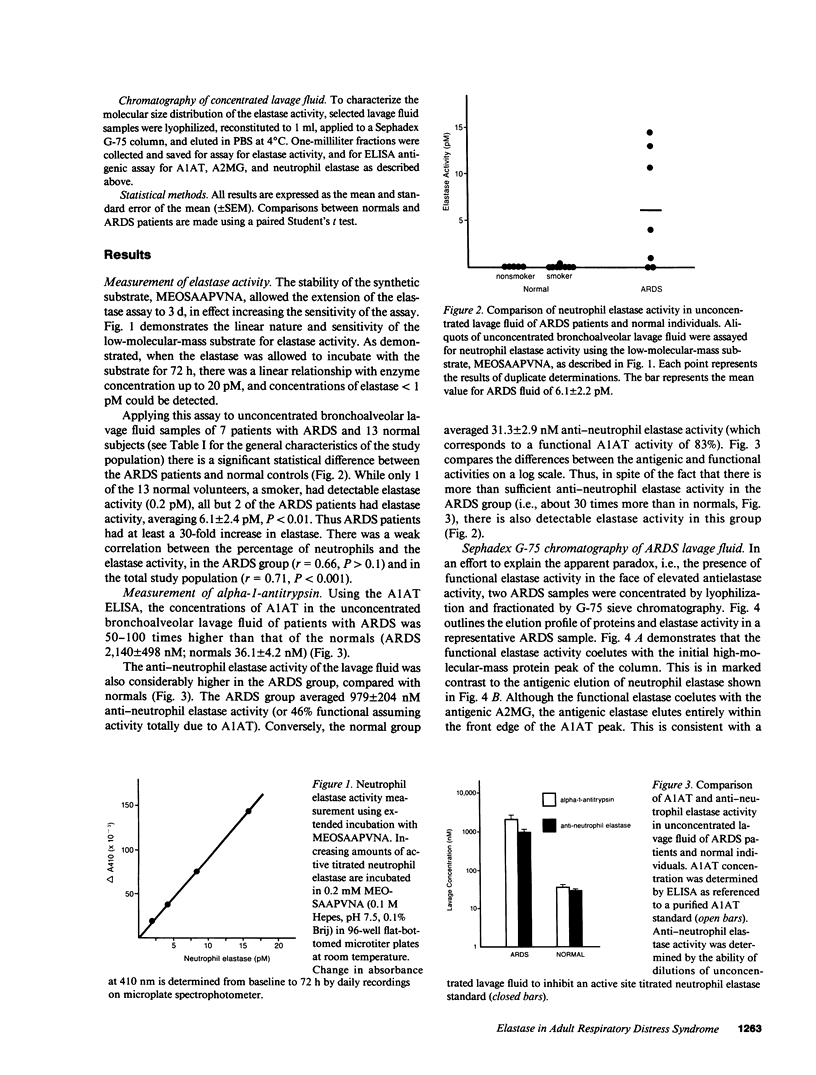
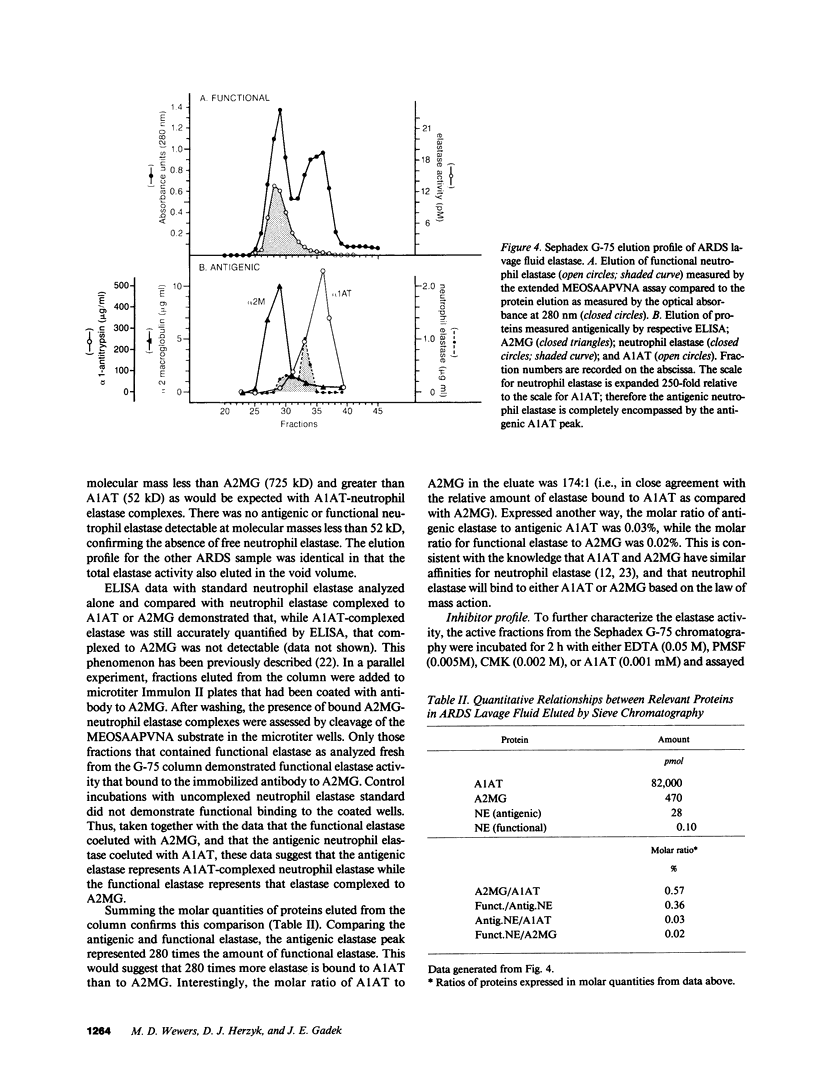
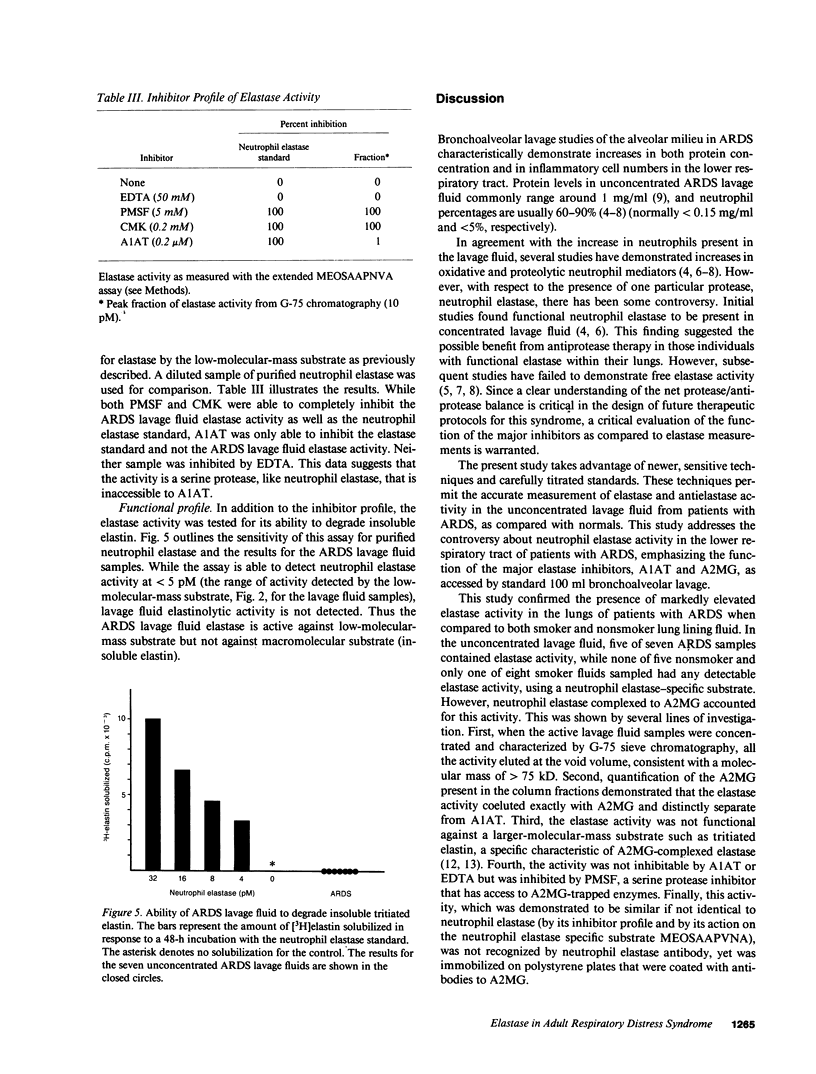
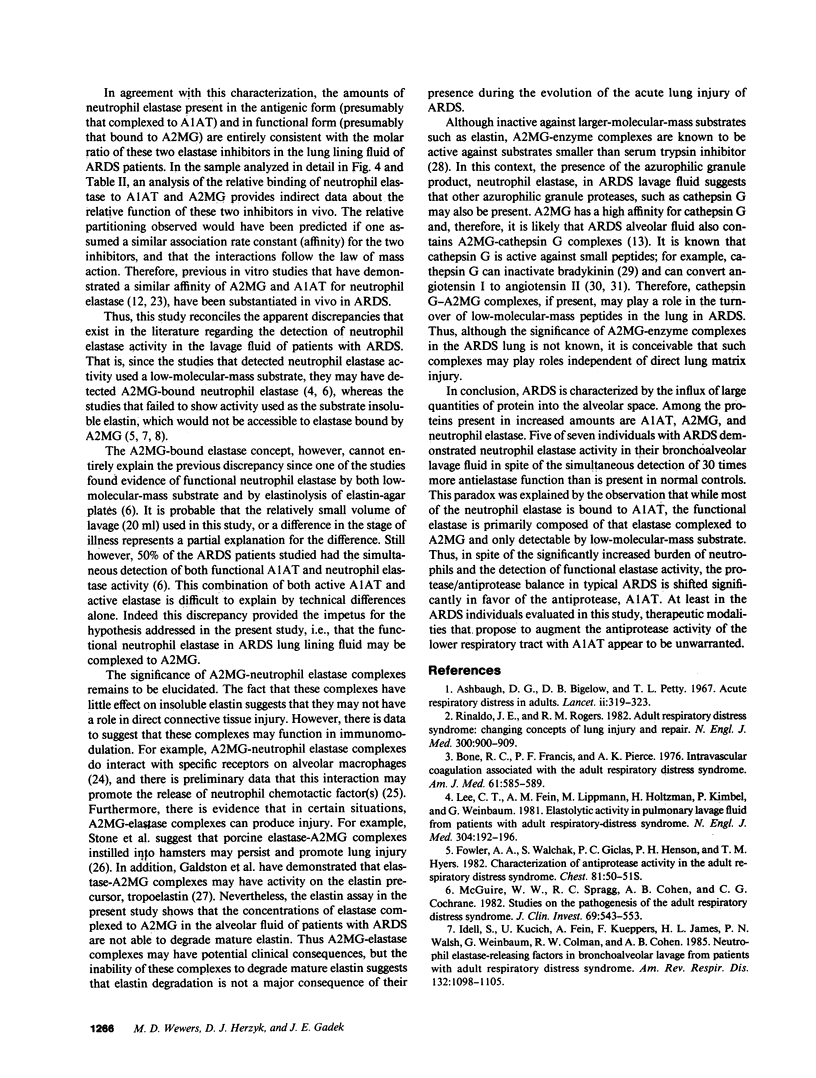
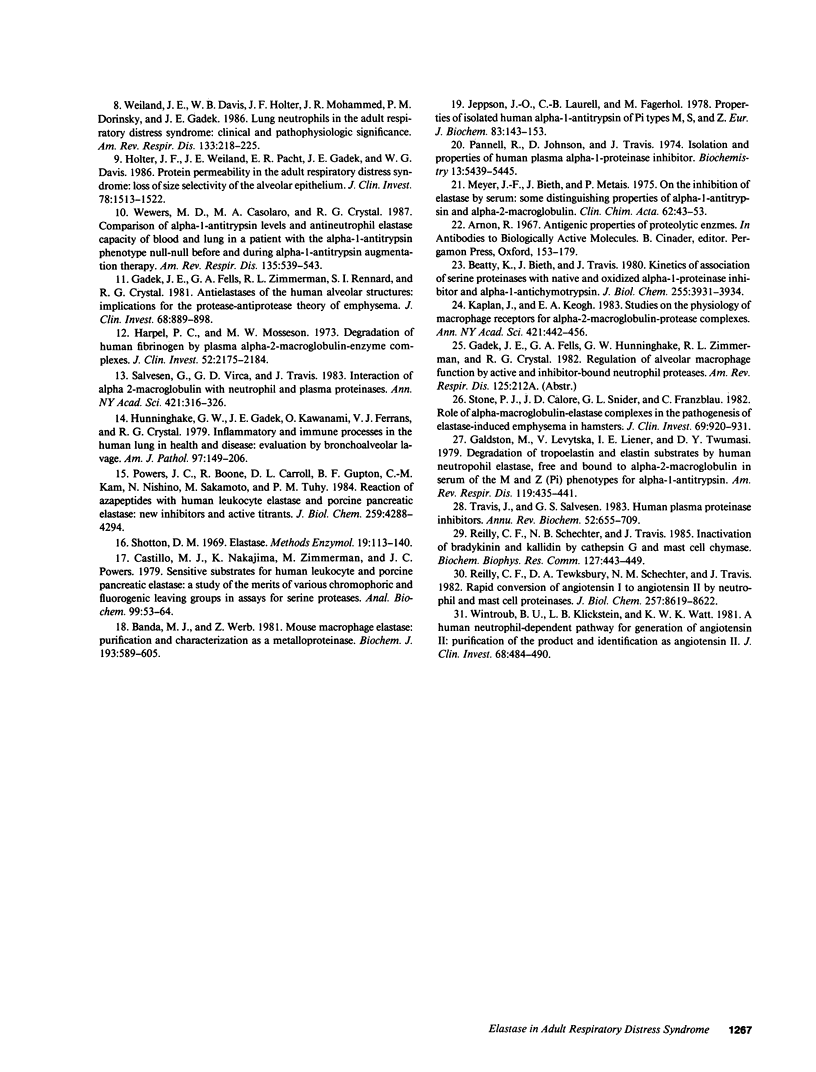
Images in this article
Selected References
These references are in PubMed. This may not be the complete list of references from this article.
- Ashbaugh D. G., Bigelow D. B., Petty T. L., Levine B. E. Acute respiratory distress in adults. Lancet. 1967 Aug 12;2(7511):319–323. doi: 10.1016/s0140-6736(67)90168-7. [DOI] [PubMed] [Google Scholar]
- Banda M. J., Werb Z. Mouse macrophage elastase. Purification and characterization as a metalloproteinase. Biochem J. 1981 Feb 1;193(2):589–605. doi: 10.1042/bj1930589. [DOI] [PMC free article] [PubMed] [Google Scholar]
- Beatty K., Bieth J., Travis J. Kinetics of association of serine proteinases with native and oxidized alpha-1-proteinase inhibitor and alpha-1-antichymotrypsin. J Biol Chem. 1980 May 10;255(9):3931–3934. [PubMed] [Google Scholar]
- Bone R. C., Francis P. B., Pierce A. K. Intravascular coagulation associated with the adult respiratory distress syndrome. Am J Med. 1976 Nov;61(5):585–589. doi: 10.1016/0002-9343(76)90135-2. [DOI] [PubMed] [Google Scholar]
- Castillo M. J., Nakajima K., Zimmerman M., Powers J. C. Sensitive substrates for human leukocyte and porcine pancreatic elastase: a study of the merits of various chromophoric and fluorogenic leaving groups in assays for serine proteases. Anal Biochem. 1979 Oct 15;99(1):53–64. doi: 10.1016/0003-2697(79)90043-5. [DOI] [PubMed] [Google Scholar]
- Gadek J. E., Fells G. A., Zimmerman R. L., Rennard S. I., Crystal R. G. Antielastases of the human alveolar structures. Implications for the protease-antiprotease theory of emphysema. J Clin Invest. 1981 Oct;68(4):889–898. doi: 10.1172/JCI110344. [DOI] [PMC free article] [PubMed] [Google Scholar]
- Galdston M., Levytska V., Liener I. E., Twumasi D. Y. Degradation of tropoelastin and elastin substrates by human neutrophil elastase, free and bound to alpha2-macroglobulin in serum of the M and Z (Pi) phenotypes for alpha1-antitrypsin. Am Rev Respir Dis. 1979 Mar;119(3):435–441. doi: 10.1164/arrd.1979.119.3.435. [DOI] [PubMed] [Google Scholar]
- Harpel P. C., Mosesson M. W. Degradation of human fibrinogen by plasms alpha2-macroglobulin-enzyme complexes. J Clin Invest. 1973 Sep;52(9):2175–2184. doi: 10.1172/JCI107402. [DOI] [PMC free article] [PubMed] [Google Scholar]
- Holter J. F., Weiland J. E., Pacht E. R., Gadek J. E., Davis W. B. Protein permeability in the adult respiratory distress syndrome. Loss of size selectivity of the alveolar epithelium. J Clin Invest. 1986 Dec;78(6):1513–1522. doi: 10.1172/JCI112743. [DOI] [PMC free article] [PubMed] [Google Scholar]
- Hunninghake G. W., Gadek J. E., Kawanami O., Ferrans V. J., Crystal R. G. Inflammatory and immune processes in the human lung in health and disease: evaluation by bronchoalveolar lavage. Am J Pathol. 1979 Oct;97(1):149–206. [PMC free article] [PubMed] [Google Scholar]
- Idell S., Kucich U., Fein A., Kueppers F., James H. L., Walsh P. N., Weinbaum G., Colman R. W., Cohen A. B. Neutrophil elastase-releasing factors in bronchoalveolar lavage from patients with adult respiratory distress syndrome. Am Rev Respir Dis. 1985 Nov;132(5):1098–1105. doi: 10.1164/arrd.1985.132.5.1098. [DOI] [PubMed] [Google Scholar]
- Jeppsson J. O., Laurell C. B., Fagerhol M. Properties of isolated human alpha1-antitrypsins of Pi types M, S and Z. Eur J Biochem. 1978 Feb 1;83(1):143–153. doi: 10.1111/j.1432-1033.1978.tb12078.x. [DOI] [PubMed] [Google Scholar]
- Kaplan J., Keogh E. A. Studies on the physiology of macrophage receptors for alpha-macroglobulin X protease complexes. Ann N Y Acad Sci. 1983;421:442–456. doi: 10.1111/j.1749-6632.1983.tb18138.x. [DOI] [PubMed] [Google Scholar]
- Lee C. T., Fein A. M., Lippmann M., Holtzman H., Kimbel P., Weinbaum G. Elastolytic activity in pulmonary lavage fluid from patients with adult respiratory-distress syndrome. N Engl J Med. 1981 Jan 22;304(4):192–196. doi: 10.1056/NEJM198101223040402. [DOI] [PubMed] [Google Scholar]
- McGuire W. W., Spragg R. G., Cohen A. B., Cochrane C. G. Studies on the pathogenesis of the adult respiratory distress syndrome. J Clin Invest. 1982 Mar;69(3):543–553. doi: 10.1172/JCI110480. [DOI] [PMC free article] [PubMed] [Google Scholar]
- Meyer J. F., Bieth J., Metais P. On the inhibition of elastase by serum. Some distinguishing properties of alpha1-antitrypsin and alpha2-macroglobulin. Clin Chim Acta. 1975 Jul 9;62(1):43–53. doi: 10.1016/0009-8981(75)90278-8. [DOI] [PubMed] [Google Scholar]
- Pannell R., Johnson D., Travis J. Isolation and properties of human plasma alpha-1-proteinase inhibitor. Biochemistry. 1974 Dec 17;13(26):5439–5445. doi: 10.1021/bi00723a031. [DOI] [PubMed] [Google Scholar]
- Powers J. C., Boone R., Carroll D. L., Gupton B. F., Kam C. M., Nishino N., Sakamoto M., Tuhy P. M. Reaction of azapeptides with human leukocyte elastase and porcine pancreatic elastase. New inhibitors and active site titrants. J Biol Chem. 1984 Apr 10;259(7):4288–4294. [PubMed] [Google Scholar]
- Reilly C. F., Schechter N. B., Travis J. Inactivation of bradykinin and kallidin by cathepsin G and mast cell chymase. Biochem Biophys Res Commun. 1985 Mar 15;127(2):443–449. doi: 10.1016/s0006-291x(85)80180-7. [DOI] [PubMed] [Google Scholar]
- Reilly C. F., Tewksbury D. A., Schechter N. M., Travis J. Rapid conversion of angiotensin I to angiotensin II by neutrophil and mast cell proteinases. J Biol Chem. 1982 Aug 10;257(15):8619–8622. [PubMed] [Google Scholar]
- Rinaldo J. E., Rogers R. M. Adult respiratory-distress syndrome: changing concepts of lung injury and repair. N Engl J Med. 1982 Apr 15;306(15):900–909. doi: 10.1056/NEJM198204153061504. [DOI] [PubMed] [Google Scholar]
- Salvesen G., Virca G. D., Travis J. Interaction of alpha 2-macroglobulin with neutrophil and plasma proteinases. Ann N Y Acad Sci. 1983;421:316–326. doi: 10.1111/j.1749-6632.1983.tb18120.x. [DOI] [PubMed] [Google Scholar]
- Stone P. J., Calore J. D., Snider G. L., Franzblau C. Role of alpha-macroglobulin-elastase complexes in the pathogenesis of elastase-induced emphysema in hamsters. J Clin Invest. 1982 Apr;69(4):920–931. doi: 10.1172/JCI110531. [DOI] [PMC free article] [PubMed] [Google Scholar]
- Travis J., Salvesen G. S. Human plasma proteinase inhibitors. Annu Rev Biochem. 1983;52:655–709. doi: 10.1146/annurev.bi.52.070183.003255. [DOI] [PubMed] [Google Scholar]
- Weiland J. E., Davis W. B., Holter J. F., Mohammed J. R., Dorinsky P. M., Gadek J. E. Lung neutrophils in the adult respiratory distress syndrome. Clinical and pathophysiologic significance. Am Rev Respir Dis. 1986 Feb;133(2):218–225. doi: 10.1164/arrd.1986.133.2.218. [DOI] [PubMed] [Google Scholar]
- Wewers M. D., Casolaro M. A., Crystal R. G. Comparison of alpha-1-antitrypsin levels and antineutrophil elastase capacity of blood and lung in a patient with the alpha-1-antitrypsin phenotype null-null before and during alpha-1-antitrypsin augmentation therapy. Am Rev Respir Dis. 1987 Mar;135(3):539–543. doi: 10.1164/arrd.1987.135.3.539. [DOI] [PubMed] [Google Scholar]
- Wintroub B. U., Klickstein L. B., Watt K. W. A human neutrophil-dependent pathway for generation of angiotensin II. Purification of the product and identification as angiotensin II. J Clin Invest. 1981 Aug;68(2):484–490. doi: 10.1172/JCI110279. [DOI] [PMC free article] [PubMed] [Google Scholar]



